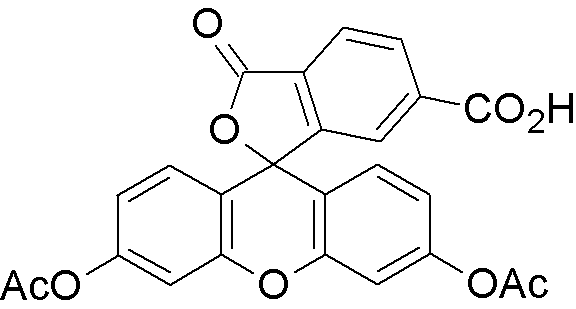6-Carboxyfluorescein diacetate is widely utilized in research focused on:
- Cell Viability Assays: This compound is commonly used in cell biology to assess cell health and viability. Researchers can easily determine the effects of drugs or treatments on living cells.
- Fluorescent Labeling: It serves as a fluorescent probe for labeling cellular components. This application is crucial in microscopy, allowing scientists to visualize and track cellular processes in real-time.
- Drug Delivery Studies: The compound is employed in studies investigating drug delivery mechanisms. Its fluorescent properties help in monitoring the distribution and release of therapeutic agents within cells.
- Environmental Monitoring: It can be used to detect and quantify pollutants in environmental samples, aiding researchers in assessing water quality and contamination levels.
- Biochemical Research: This chemical plays a role in various biochemical assays, including enzyme activity studies, where its fluorescence can indicate reaction progress or product formation.
Información general
Propiedades
Seguridad y normativas
Aplicaciones
6-Carboxyfluorescein diacetate is widely utilized in research focused on:
- Cell Viability Assays: This compound is commonly used in cell biology to assess cell health and viability. Researchers can easily determine the effects of drugs or treatments on living cells.
- Fluorescent Labeling: It serves as a fluorescent probe for labeling cellular components. This application is crucial in microscopy, allowing scientists to visualize and track cellular processes in real-time.
- Drug Delivery Studies: The compound is employed in studies investigating drug delivery mechanisms. Its fluorescent properties help in monitoring the distribution and release of therapeutic agents within cells.
- Environmental Monitoring: It can be used to detect and quantify pollutants in environmental samples, aiding researchers in assessing water quality and contamination levels.
- Biochemical Research: This chemical plays a role in various biochemical assays, including enzyme activity studies, where its fluorescence can indicate reaction progress or product formation.
Documentos
Hojas de datos de seguridad (HDS)
La SDS proporciona información de seguridad completa sobre la manipulación, el almacenamiento y la eliminación del producto.
Especificación del producto (PS)
La PS proporciona un desglose completo de las propiedades del producto, incluida la composición química, el estado físico, la pureza y los requisitos de almacenamiento. También detalla los rangos de calidad aceptables y las aplicaciones previstas del producto.
Certificados de análisis (COA)
Busque certificados de análisis (COA) ingresando el número de lote del producto. Los números de lote y de partida se pueden encontrar en la etiqueta de un producto después de las palabras "Lote" o "Lote".
Número de catálogo
Número de lote/lote
Certificados de origen (COO)
Este certificado de origen confirma el país en el que se fabricó el producto y también detalla los materiales y componentes utilizados en él y si se deriva de fuentes naturales, sintéticas u otras fuentes específicas. Este certificado puede ser necesario para cumplir con las normativas aduaneras, comerciales y regulatorias.
Número de catálogo
Número de lote/lote
Hojas de datos de seguridad (HDS)
La SDS proporciona información de seguridad completa sobre la manipulación, el almacenamiento y la eliminación del producto.
DownloadEspecificación del producto (PS)
La PS proporciona un desglose completo de las propiedades del producto, incluida la composición química, el estado físico, la pureza y los requisitos de almacenamiento. También detalla los rangos de calidad aceptables y las aplicaciones previstas del producto.
DownloadCertificados de análisis (COA)
Busque certificados de análisis (COA) ingresando el número de lote del producto. Los números de lote y de partida se pueden encontrar en la etiqueta de un producto después de las palabras "Lote" o "Lote".
Número de catálogo
Número de lote/lote
Certificados de origen (COO)
Este certificado de origen confirma el país en el que se fabricó el producto y también detalla los materiales y componentes utilizados en él y si se deriva de fuentes naturales, sintéticas u otras fuentes específicas. Este certificado puede ser necesario para cumplir con las normativas aduaneras, comerciales y regulatorias.


